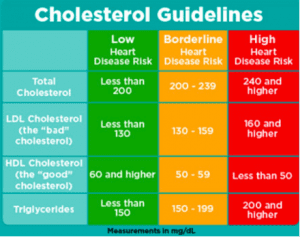Written by UConn Dietetics student Madeline Fulton
93 million U.S. adults age 20 or older have total cholesterol levels higher than 200 mg/dL. Nearly 29 million adult Americans have total cholesterol levels higher than 240 mg/dL.1
Too much cholesterol circulating in your blood can put you at risk for developing heart disease and stroke. What is cholesterol? It’s a waxy, fat-like substance made by our livers. Cholesterol is needed for our bodies to produce hormones, digest fatty foods, and other important jobs. Our bodies produce the right amount of cholesterol needed. There are two types of cholesterol we care most about: “GOOD” (aka HDL) and “BAD” (aka LDL). We want more “GOOD” cholesterol in our bodies because it helps our bodies get rid of the “BAD” cholesterol. The “BAD”, or less healthy cholesterol, can build up over time and cause our arteries to become stiff and narrow. This reduces the blood flow which could result in blockage to the heart (a heart attack) or the brain (a stroke). Cholesterol in our blood is affected MOST by eating saturated fats (fatty meats, butter, baked goods) and trans fats (fried fast food, vegetable oil, microwave popcorn, some stick margarines).
The way you can help yourself and improve your cholesterol levels is to:
- KNOW YOUR NUMBERS. Don’t miss doctor’s appointments or lab work.
- Learn and be aware of the foods that can help you control your good and bad cholesterol, as well as, the saturated and trans fats you eat:
- “Good” cholesterol (aka HDL) is affected in a good way by foods like nuts, seeds, legumes, olive oil, canola oil, fatty fish (salmon, mackerel, tuna), flax and chia seeds, avocado, high fiber fruits and vegetables, and whole grains.
- “Bad” cholesterol (aka LDL) is affected by foods like fatty cuts of meat, full-fat dairy products, deep-fried fast foods, processed foods (chips, cookies, other snack foods), and butter.
- Review your diet. Only on occasion should you eat rich (highly marbled) meats, cream, butter, and fried foods.
- Participate in at least 150 minutes of moderate physical activity per week. Aerobic exercise (those that increase your heart rate) can help improve your GOOD cholesterol levels. Aerobic types of exercise include: walking, running, biking, or jumping rope.2
- Drink alcohol in moderation. The current recommendation for females is up to one drink per day; while the recommendation for males is up to two drinks per day. “One drink” is considered one glass (5 oz.) of wine, one beer (12 oz), or 1.5 oz of hard liquor.3
- If diet and exercise plans don’t seem to be lowering your cholesterol numbers into a healthy range, medication might be necessary. Make sure to speak with your doctor to see what plan will work best for you!
Tip: Small changes go a long way when it comes to managing your cholesterol! The small changes will add up, helping you to develop long-lasting lifestyle and nutrition changes.
Citations
- Virani SS, Alonso A, Benjamin EJ, Bittencourt MS, Callaway CW, Carson AP, et al. Heart disease and stroke statistics—2020 update: a report from the American Heart Association. Circulation. 2020. Accessed September 21, 2020.
- S. Department of Health and Human Services. 2008. Health (San Francisco) 2008 Physical Activity. Accessed September 21, 2020.
- Agriculture, U.S. Department of Health and Human Services and U.S. Department of. 2015. “2015 – 2020 Dietary Guidelines for Americans.” 2015 – 2020 Dietary Guidelines for Americans (8th edition). Accessed September 21, 2020.
This material is funded by USDA’s Supplemental Nutrition Assistance Program (SNAP).
This institution is an equal opportunity provider.
